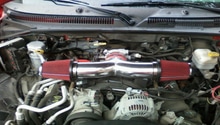Dodge Ram: How to Clean Engine Bay
Don't let dirt and other debris contaminate your engine bay; read on to learn how you can blast away contaminants for improved engine lifespan.
This article applies to the Dodge Ram (1994-present).
The more you drive your Dodge Ram the more your engine bay is likely to become contaminated by dangerous contaminants that can came slow performance and decrease the lifespan of your engine. Luckily, there are a number of do-it-yourself and professional solutions to this common problem. While you won't need an incredible amount of automotive experience, you will need to work under the hood of your truck for this project. Aside from a few safety measures for you and your truck, you will need to take care not to expose your battery and other parts to water and liquid cleaning products while you work.

Materials Needed
- Battery blanket (optional)
- Engine degreaser
- Microfiber cloth
- Orange Clean Degreaser or 409 (optional)
- Blankets and shop towels
Step 1 – Remove battery
Remove your battery by disconnecting the battery terminals one at a time, and then cover ALL electrical components to avoid longstanding damage in the future. It's highly recommended that you use a blanket or shop towels to shield your alternator, distributor, fuse box, radiator support, power train control module and air cleaner from damage due to runoff.

Step 2 – Apply a cleaner to a microfiber cloth
Grab your heavy duty engine degreaser and bristled cleaning brush or microfiber cloth, and start scrubbing away stubborn deposits, paying special attention to the firewalls and inner fenderwells as you progress. Some Dodge Ram owners swear by the powdered cleaning power of Comet, a household cleaning product that retails for several dollars at your local grocer's store; however, the choice to use it is up to you.
- Avoid spraying liquid solutions directly onto electrical connections and sensors.
- For areas where there is minimum dirt or risk for damaging other parts, create a 50/50 solution of household degreaser and water.
- Wet a microfiber cloth with the solution, and then use it to clean your engine bay.
- If you do happen to splash water on one of the above-mentioned parts, stop working.
- Allow your vehicle to sit for 30 minutes, and then try starting it again. If you experience any difficulties, visit a certified, licensed mechanic for professional support.

Pro Tips
- Engine degreasers are specially formulated to clean dirt, dust and road grime, which can become lodged in your engine bay. Using Orange Clean Degreaser is recommended, and 409 is also an excellent product.
- It's not recommended that you use any kind of pressurized rinsing or steaming tools for this project; although it's important to note, professional engine steaming services are offered by licensed technicians. Only use a garden hose on a low and controlled setting.
- If you get water into your alternator, your truck could experience loud mechanic noises and squealing for some time.
Step 3 – Rinse or wipe down the newly cleaned areas
Wipe away excess residue and product for a clean finish. Pat the engine bay down with a dry, microfiber cloth or leave your hood open so your engine can air dry.
Step 4 – Finishing up
Once the engine bay and its components are fully dried, re-install and connect the battery and remove all shop rags and blankets covering various parts mentioned in Step 1.
Related Discussions
- Engine Bay Cleaning Tips - Dodgeforum.com
- Engine Bay Cleaning Warnings - Dodgeforum.com






